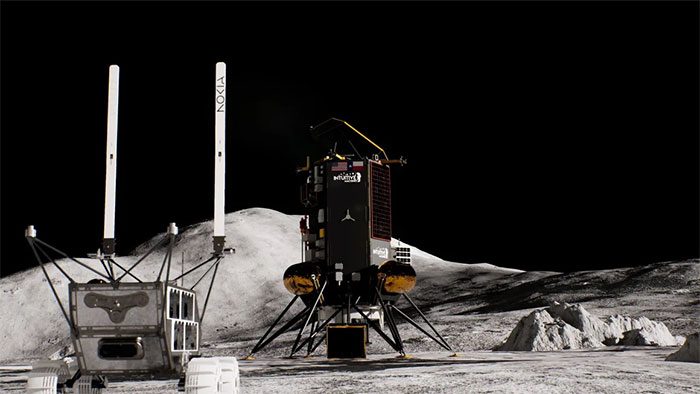Text Messaging on the Moon: Establishing a 4G Network
NASA and Nokia have partnered to establish a 4G mobile network on the Moon, set to launch soon via a SpaceX rocket this year, with an exact date yet to be confirmed. This lander will install the system at the Moon’s south pole and will be remotely operated from Earth.
Walt Engelund from NASA stated that this process presents numerous challenges as the network must function in the harsh lunar environment, which includes extreme temperatures and radiation.

Simulation image of the Lunar Outpost spacecraft, featuring an extended Nokia antenna on the Moon. Nokia and NASA are working to establish a 4G mobile network on the lunar surface. (Photo: Nokia Bell Labs)
“The first challenge in setting up and operating the network is ensuring that the mobile devices meet space-grade standards, fulfilling size, weight, and power requirements, and can be deployed without the need for technicians,” he said.
The 4G network equipment is being developed by Nokia’s Bell Labs. This equipment will be sent aboard a lander manufactured by the American company Intuitive Machines. Once deployed, it will connect the lander via radio equipment to two rovers, tasked with the special mission of searching for ice.
One of the vehicles, known as the Micro-Nova Funnel, will plunge into a crater to search for unprecedented close-up evidence of ice on the Moon. Images of the first lunar ice will be transmitted back to the lander and then sent to Earth almost in real-time through the mobile network. Lunar ice could be used to produce oxygen and even fuel, which could later be utilized for Mars missions from the Moon.
For NASA’s Artemis program, which aims to return astronauts to the Moon this decade, mobile connectivity is crucial.
Engelund noted that currently, astronauts communicate with each other via radio, but NASA wants a lunar communication system capable of supporting scientific data and high-resolution video, especially as Artemis missions become more complex.
“This effort will help establish a communication network on the Moon that can provide our explorers with the ability to transmit scientific data, communicate with mission control, and talk with their families, as if they were walking down the street using a mobile phone.”
This initiative could lay the groundwork for an off-Earth Internet. Personal devices could connect to the network, allowing those in space to use smartphones to access all available applications and services as if they were on Earth.
Bell Labs received $14.1 million in funding in 2020. In January 2024, the U.S. Defense Advanced Research Projects Agency (DARPA) selected Nokia to begin developing communication service infrastructure, which will serve as a “framework for the lunar economy.”
If a mobile network can withstand the journey into orbit, then deploy and function autonomously in the vacuum of space, enduring extreme temperature fluctuations and cosmic radiation, it will also be capable of surviving in the harshest environments on Earth, such as polar ice caps, deserts, or offshore locations.


















































